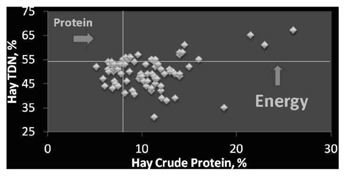Forage Quality Could Impact Cow Performance
LEXINGTON, KY.
The wet spring last year resulted in several acres of hay that were
cut and baled late. This can be problematic since much of our hay is
derived from fescue and fescue-legume mix stands. The later the hay
harvest, the more the plants advance in maturity from a vegetative
stage, which is all leaf, to an advanced re-productive stage when the
seeds are developed.
The ideal time to harvest cool-season grass for hay from a yield and
quality perspective is from boot stage (i.e. just prior to the flower
emerging from the stem) to early flowering. Due to the excessive
precipitation received last year, many fields were cut beyond this ideal
time frame. Hay that was in the soft dough to fully ripened seed stage
was harvested from several fields. The quality of hay at these later
stages of maturity poses problems for our beef cattle, especially those
with high nutritional needs such as lactating cows and growing calves.

The figure is a plot of approximately 60 forage analysis from hay
sampled in 2013. The lines represent the energy and protein needs for a
cow in late gestation. Hay samples that are left of the vertical line
require protein supplementation. Samples below the horizontal line are
energy deficient. Thus, those in the lower left quadrant are both energy
and protein deficient while those in the upper right quadrant exceed
both the energy and protein requirements. You should be able to see that
many of the hay samples are adequate in protein but deficient in
energy. Thus, in many instances, energy is first limiting during this
phase of production while protein will likely be limiting along with
energy as the cows start their lactations.
Late cut hay is lower in protein and is less digestible leading to
less energy available to the animal. The low protein and lower
digestibility of this hay also negatively impacts forage intake. This
can lead to lactating cows being in a severe negative energy balance
resulting in excessive body tissue mobilization to support nutritional
needs. The loss of body condition can negatively impact reproduction
costing the operation in the long term.
To ensure the livestock are receiving an adequately balanced diet,
producers should sample their hay and have it analyzed for nutrient
content. This information is then used to develop a strategic
supplementation strategy for cattle. Their nutritional requirements at
different stages of production must be taken into account. In other
words, dry, non-lactating bred cows in the mid-trimester of gestation
will have lower nutritional needs than cows 60 days from calving in
which rapid fetal growth is occurring. Forage analysis allows ranchers
to more efficiently match hay quality to the nutrient needs of the cows.
Producers that wish to utilize their forage analysis in developing a
supplementation strategy should visit
http://apps.ca.uky.edu/forage-supplement-tool/ by searching the internet
using the key-words Kentucky Forage Tool. This simple web program
allows a producer to enter a few pieces of information from their hay
analysis, select the stage of production the cows are in along with
various supplements to arrive at a supplementation program. It was
developed to help producers utilize their hay analysis rather than
simply look at the paper and toss it in a drawer. Producers are still
encouraged to contact their nutritionist or county Extension agent for
assistance in designing supplement programs. This tool will, however,
get a cow-calf operator start-ed down the right track. Stay warm and
supplement smart this winter. ∆
DR. JEFF LEHMKUHLER: Extension Beef Specialist, University of Kentucky